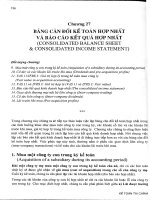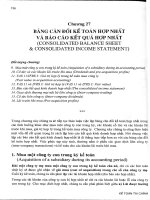Gíao trình kế toán bằng tiếng anh ch04
Bạn đang xem bản rút gọn của tài liệu. Xem và tải ngay bản đầy đủ của tài liệu tại đây (387.57 KB, 4 trang )
CHAPTER 4—PROBLEMS: SET B
P4-1B VideoPlus, Inc. manufactures two types of DVD players, a deluxe model and a
standard model. The deluxe model is a multi-format progressive-scan DVD player with
networking capability, Dolby digital, and DTS decoder. The standard model’s primary feature is progressive-scan. Annual production is 50,000 units for the deluxe and 20,000 units
for the standard.
Both products require two hours of direct labor for completion. Therefore, total annual
direct labor hours are 140,000 [2 hrs. 3 (20,000 1 50,000)]. Expected annual manufacturing overhead is $1,050,000. Thus, the predetermined overhead rate is $7.50 ($1,050,000 4
140,000) per direct labor hour. The direct materials cost per unit is $42 for the deluxe
model and $11 for the standard model. The direct labor cost is $18 per unit for both the
deluxe and the standard models.
The company’s managers identified six activity cost pools and related cost drivers and
accumulated overhead by cost pool as follows.
Activity Cost Pool
Cost Driver
Estimated
Overhead
Purchasing
Receiving
Assembling
Testing
Finishing
Packing and shipping
Orders
Pounds
Number of parts
Number of tests
Units
Pounds
$ 126,000
30,000
444,000
115,000
140,000
195,000
Expected
Use of
Cost
Drivers
Standard
Deluxe
400
20,000
74,000
23,000
70,000
80,000
100
4,000
20,000
10,000
20,000
18,000
300
16,000
54,000
13,000
50,000
62,000
Assign overhead using
traditional costing and ABC;
compute unit costs; classify
activities as value- or non–
value-added.
(LO 1, 4, 6), AP
Expected Use of
Drivers by Product
$1,050,000
Instructions
(a) Under traditional product costing, compute the total unit cost of both products.
Prepare a simple comparative schedule of the individual costs by product (similar to
Illustration 4-10).
(b) Under ABC, prepare a schedule showing the computations of the activity-based overhead rates (per cost driver).
(c) Prepare a schedule assigning each activity’s overhead cost pool to each product based
on the use of cost drivers. (Include a computation of overhead cost per unit, rounding
to the nearest cent.)
(d) Compute the total cost per unit for each product under ABC.
(e) Classify each of the activities as a value-added activity or a non–value-added activity.
(f) Comment on (1) the comparative overhead cost per unit for the two products under
ABC, and (2) the comparative total costs per unit under traditional costing and ABC.
P4-2B Kinnard Electronics manufactures two home theater systems: the Elite which sells
for $1,400, and a new model, the Preferred, which sells for $1,100. The production cost
computed per unit under traditional costing for each model in 2014 was as follows.
Traditional Costing
Elite
Preferred
Direct materials
Direct labor ($20 per hour)
Manufacturing overhead ($35 per DLH)
$600
100
175
$320
80
140
Total per unit cost
$875
$540
(a) Unit cost—Standard $44
(c) Cost assigned—Standard
$291,375
(d) Cost/unit—Standard $43.57
Assign overhead to products
using ABC and evaluate
decision.
(L0 4), AP
In 2014, Kinnard manufactured 20,000 units of the Elite and 10,000 units of the Preferred. The overhead rate of $35 per direct labor hour was determined by dividing total
expected manufacturing overhead of $4,900,000 by the total direct labor hours (140,000)
for the two models.
P-1
P-2
Problems: Set B
Under traditional costing, the gross profit on the models was Elite $525 ($1,400 2
$875), and Preferred $560 ($1,100 2 $540). Because of this difference, management is considering phasing out the Elite model and increasing the production of the Preferred model.
Before finalizing its decision, management asks Kinnard’s controller to prepare an
analysis using activity-based costing (ABC). The controller accumulates the following information about overhead for the year ended December 31, 2014.
Activity
Purchasing
Machine setups
Machining
Quality control
Cost Driver
Estimated
Overhead
Expected
Use of
Cost
Drivers
Number of orders
Number of setups
Machine hours
Number of inspections
$ 775,000
580,000
3,100,000
445,000
25,000
20,000
100,000
5,000
ActivityBased
Overhead
Rate
$31
29
31
89
The cost drivers used for each product were:
(a) Elite $2,152,500
(b) Cost/unit—Elite $807.63
Assign overhead costs using
traditional costing and ABC;
compare results.
(L0 1, 4), AN
Cost Driver
Elite
Preferred
Total
Purchase orders
Machine setups
Machine hours
Inspections
11,250
11,000
40,000
2,750
13,750
9,000
60,000
2,250
25,000
20,000
100,000
5,000
Instructions
(a) Assign the total 2014 manufacturing overhead costs to the two products using activitybased costing (ABC) and determine the overhead cost per unit.
(b) What was the cost per unit and gross profit of each model using ABC costing?
(c)
Are management’s future plans for the two models sound? Explain.
P4-3B Luxury Furniture designs and builds factory-made, premium, wood armoires for
homes. All are of white oak. Its budgeted manufacturing overhead costs for the year 2014
are as follows.
Overhead Cost Pools
Amount
Purchasing
Handling materials
Production (cutting, milling, finishing)
Setting up machines
Inspecting
Inventory control (raw materials and finished goods)
Utilities
$ 45,000
50,000
130,000
85,000
60,000
80,000
100,000
Total budgeted overhead costs
$550,000
For the last four years, Luxury Furniture has been charging overhead to products on
the basis of materials cost. For the year 2014, materials cost of $500,000 were budgeted.
Jim Brigham, owner-manager of Luxury Furniture, recently directed his accountant,
Bob Borke, to implement the activity-based costing system that he has repeatedly proposed. At Jim Brigham’s request, Bob and the production foreman identify the following
cost drivers and their usage for the previously budgeted overhead cost pools.
Overhead Cost Pools
Activity Cost Drivers
Expected
Use of
Cost Drivers
Purchasing
Handling materials
Production (cutting, milling, finishing)
Setting up machines
Inspecting
Inventory control (raw materials
and finished goods)
Utilities
Number of orders
Number of moves
Direct labor hours
Number of setups
Number of inspections
500
5,000
65,000
1,000
4,000
Number of components
Square feet occupied
40,000
50,000
Problems: Set B
P-3
Debbie Steiner, sales manager, has received an order for 12 luxury armoires from
Thom’s Interior Design. At Debbie’s request, Bob prepares cost estimates for producing 12
armoires so Debbie can submit a contract price per armoire to Thom’s. He accumulates
the following data for the production of 12 armoires.
Direct materials
Direct labor
Direct labor hours
Number of purchase orders
Number of material moves
Number of machine setups
Number of inspections
Number of components
Number of square feet occupied
$5,200
$3,500
200
3
32
4
20
640
320
Instructions
(a) Compute the predetermined overhead rate using traditional costing with materials
cost as the basis.
(b) What is the manufacturing cost per armoire under traditional costing?
(c) What is the manufacturing cost per armoire under the proposed activity-based costing? (Prepare all of the necessary schedules.)
(d)
Which of the two costing systems is preferable in pricing decisions and why?
P4-4B Merando Corporation produces two grades of wine from grapes that it buys from
California growers. It produces and sells roughly 600,000 gallon jugs per year of a lowcost, high-volume product called Valley Fresh. Merando also produces and sells roughly
200,000 gallons per year of a low-volume, high-cost product called Merando Valley.
Merando Valley is sold in 1-liter bottles. Based on recent data, the Valley Fresh product
has not been as profitable as Merando Valley. Management is considering dropping the
inexpensive Valley Fresh line so it can focus more attention on the Merando Valley product.
The Merando Valley product already demands considerably more attention than the Valley
Fresh line.
Frankie Merando, president and founder of Merando, is skeptical about this idea. He
points out that for many decades the company produced only the Valley Fresh line, and
that it was always quite profitable. It wasn’t until the company started producing the
more complicated Merando Valley wine that the profitability of Valley Fresh declined.
Prior to the introduction of Merando Valley, the company had simple equipment, simple
growing and production procedures, and virtually no need for quality control. Because
Merando Valley is bottled in one-liter bottles, it requires considerably more time and
effort, both to bottle and to label and box, than does Valley Fresh. The company must
bottle and handle four times as many bottles of Merando Valley to sell the same quantity
as Valley Fresh, since there are approximately four liters in a gallon. Valley Fresh requires
one month of aging; Merando Valley requires one year. Valley Fresh requires cleaning and
inspection of equipment every 2,500 gallons; Merando Valley requires such maintenance
every 250 gallons.
Frankie has asked the accounting department to prepare an analysis of the cost per
gallon using the traditional costing approach and using activity-based costing. The following information was collected.
Direct materials per gallon
Direct labor cost per gallon
Direct labor hours per gallon
Total direct labor hours
Valley Fresh
Merando Valley
$1.35
$0.75
0.05
30,000
$3.60
$1.50
0.10
20,000
(b) Cost/armoire $1,201.67
(c) Cost/armoire $1,020.83
Assign overhead costs using
traditional costing and ABC;
compare results.
(L0 1, 4), AN
P-4
Problems: Set B
Activity Cost Pool
Cost Driver
Grape processing
Aging
Bottling and
corking
Labeling and
boxing
Maintain and
inspect equipment
Cart of grapes
Total months
Number of
bottles
Number of
bottles
Number of
inspections
Expected Use
of Cost Drivers
per Product
Estimated
Overhead
Expected
Use of
Cost
Drivers
Valley Fresh
Merando Valley
$ 146,000
420,000
8,000
3,000,000
6,000
600,000
2,000
2,400,000
210,000
1,400,000
600,000
800,000
140,000
1,400,000
600,000
800,000
234,000
1,040
240
800
$1,150,000
Instructions
Answer each of the following questions. (Round all calculations to three decimal places.)
(a) Under traditional product costing using direct labor hours, compute the total manufacturing cost per gallon of both products.
(b) Under ABC, prepare a schedule showing the computation of the activity-based overhead rates (per cost driver).
(c) Prepare a schedule assigning each activity’s overhead cost pool to each product, based
on the use of cost drivers. Include a computation of overhead cost per gallon.
(d) Compute the total manufacturing cost per gallon for both products under ABC.
(e)
Write a memo to Frankie Merando discussing the implications of your analysis for the company’s plans. In this memo, provide a brief description of ABC as well
as an explanation of how the traditional approach can result in distortions.
(a) Cost/gallon—V.F. $3.25
(c) Cost/gallon—V.F. $0.663
Assign overhead costs to
services using traditional
costing and ABC; compute
overhead rates and unit costs;
compare results.
(L0 1, 4, 6, 8), AN
P4-5B Smith and Jones is a law firm that serves both individuals and corporations. A
controversy has developed between the partners of the two service lines as to who is contributing the greater amount to the bottom line. The area of contention is the assignment
of overhead. The individual partners argue for assigning overhead on the basis of 30% of
direct labor dollars, while the corporate partners argue for implementing activity-based
costing. The partners agree to use next year’s budgeted data for purposes of analysis and
comparison. The following overhead data are collected to develop the comparison.
Activity Cost Pool
Cost Driver
Employee training
Typing and
secretarial
Computing
Facility rental
Travel
Direct labor dollars
Number of reports/
forms
Number of minutes
Number of employees
Per expense reports
Expected Use
of Cost Drivers
per Service
Estimated
Overhead
Expected
Use of
Cost
Drivers
Corporate
Individual
$120,000
$1,600,000
$900,000
$700,000
60,000
130,000
100,000
70,000
2,000
40,000
25
Direct
500
17,000
14
48,000
1,500
23,000
11
22,000
$480,000
(b) (2) Cost assigned—
Individual $238,250
(c) Difference—Corporate
$28,250
Instructions
(a) Using traditional product costing, compute the total overhead cost assigned to both
services (individual and corporate) of Smith and Jones.
(b) (1) Using activity-based costing, prepare a schedule showing the computations of the
activity-based overhead rates (per cost driver).
(2) Prepare a schedule assigning each activity’s overhead cost pool to each service
based on the use of the cost drivers.
(c)
Comment on the comparative overhead for the two service lines under both
traditional costing and ABC.









